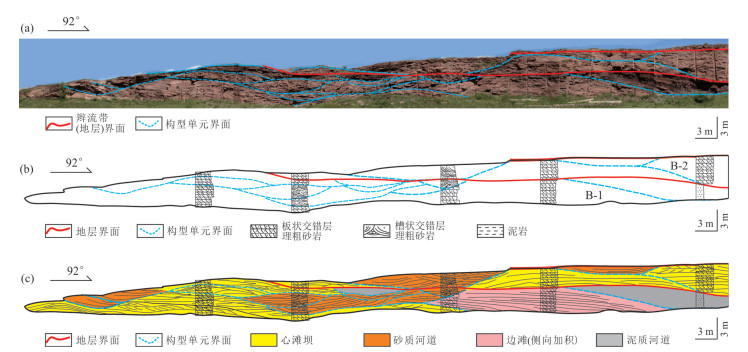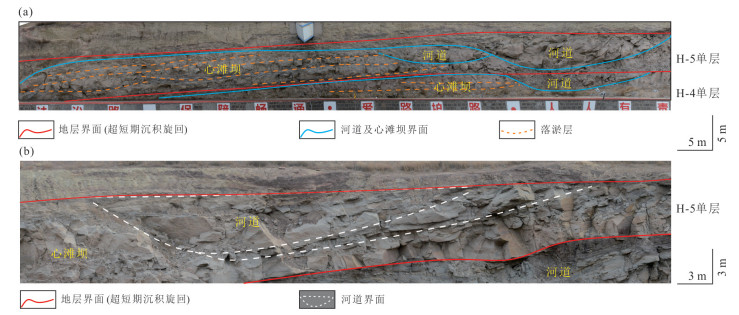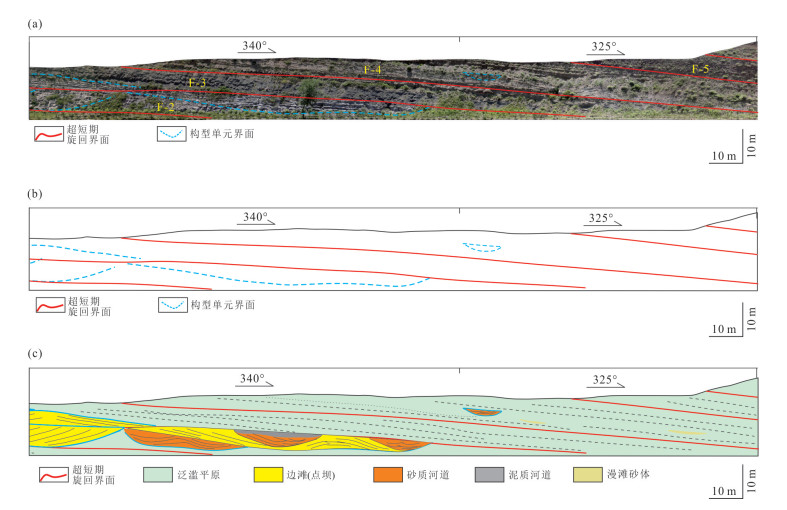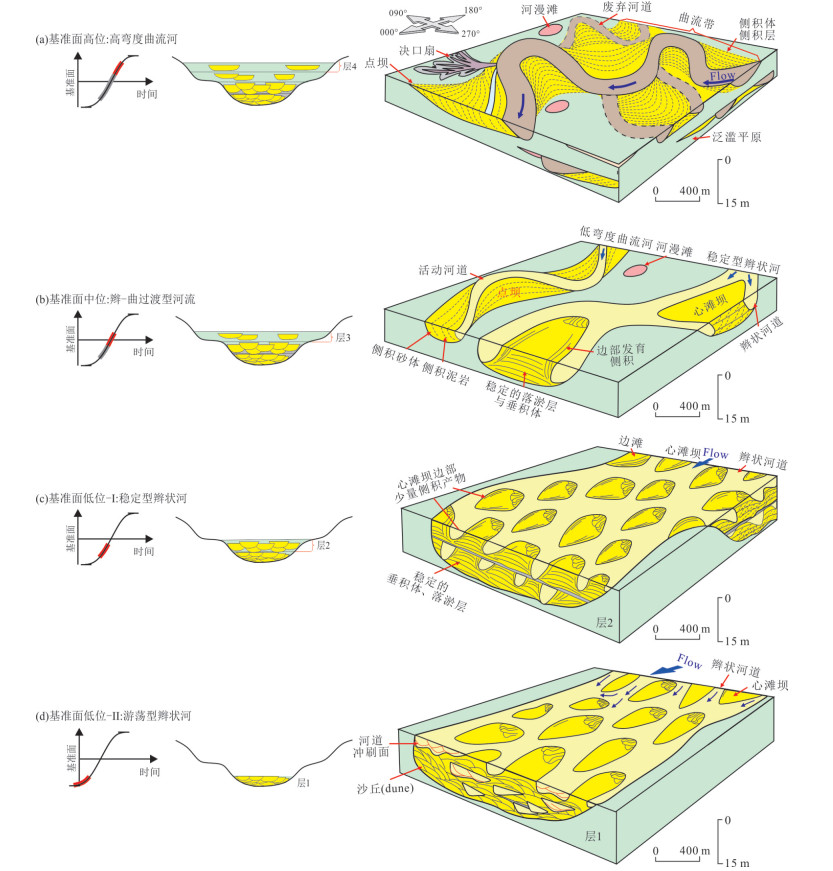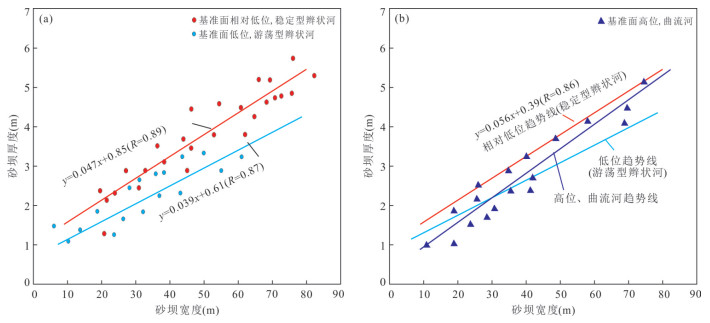|
Bai, H., 2011. Mesozoic Prototype Basin Restoration in Datong Basin (Dissertation). China University of Petroleum, Beijing (in Chinese with English abstract). |
|
Best, J. L., Ashworth, P. J., Bristow, C. S., et al., 2003. Three-Dimensional Sedimentary Architecture of a Large, Mid-Channel Sand Braid Bar, Jamuna River, Bangladesh. Journal of Sedimentary Research, 73(4): 516-530. https://doi.org/10.1306/010603730516 |
|
Bradley, R. W., Venditti, J. G., 2017. Revaluating Dune Scaling Relations. Earth-Science Reviews, 165: 356-376. https://doi.org/10.1016/j.earscirev.2016.11.004 |
|
Bridge, J. S., Lunt, I. A., 2006. Depositional Models of Braided Rivers. In: Smith, G. H. S., Best, J. L., Bristow, C. S., et al., eds., Braided Rivers: Process, Deposits, Ecology and Management (1st Edition). Blackwell Publishing, Oxford, 11-50. https://doi.org/10.1002/9781444304374.ch2 |
|
Chen, B. T., Yu, X. H., Wang, T. Q., et al., 2015. Lithofacies and Architectural Characteristics of Sandy Braided River Deposits: A Case from Outcrops of the Middle Jurassic Yungang Formation in the Datong Basin, Shanxi Province. Oil & Gas Geology, 36(1): 111-117 (in Chinese with English abstract). |
|
Chen, Y. K., Wu, S. H., Mao, P., et al., 2012. Characterization of Sandy Braided River Reservoir Configuration-An Example from Guantao Formation in Yangsanmu Oilfield, Dagang Oil Region. Xinjiang Petroleum Geology, 33(5): 523-526 (in Chinese with English abstract). |
|
Chen, Y. K., Wu, S. H., Wang, Y. J., et al., 2015. Distribution Patterns of the Fall-Siltseams in the Channel Bar of the Perennial Sandy Braided River: An Approach. Sedimentary Geology and Tethyan Geology, 35(1): 96-101, 112 (in Chinese with English abstract). doi: 10.3969/j.issn.1009-3850.2015.01.012 |
|
Chen, Y. X., Dai, D. L., 1962. Sedimentary Facies of Jurassic in Datong Area, Shanxi Province. Acta Geologica Sinica, 42(3): 321-336, 354 (in Chinese with English abstract). |
|
Colombera, L., Mountney, N. P., 2020. Accommodation and Sediment-Supply Controls on Clastic Parasequences: A Meta-Analysis. Sedimentology, 67: 1667-1709. https://doi.org/10.1111/set.12728 |
|
Crosato, A., Mosselman, E., 2009. Simple Physics-Based Predictor for the Number of River Bars and the Transition between Meandering and Braiding. Water Resources Research, 45(3): 1-14. https://doi.org/10.1029/2008WRoo7242 |
|
Cross, T. A., 1988. Controls on Coal Distribution in Transgressive-Regressive Cycles, Upper Cretaceous, Western Interior, U. S. A. . In: Wilgaus, C. K., Hastings, B. S., Posamentier, H., et al., eds., Sea-Level Changes: An Integrated Approach. SEPM Special Publication, 42: 371-380. https://doi.org/10.2110/pec.88.01.0371 |
|
Cross, T. A., 2000. Stratigraphic Controls on Reservoir Attributes in Continental Strata. Earth Science Frontiers, 7(4): 322-350. |
|
Deng, H. W., Wang, H. L., Li, X. M., et al., 1997. Application of Base Level Principle in Prediction of Lacustrine Reservoirs. Oil & Gas Geology, 18(2): 90-95, 114 (in Chinese with English abstract). |
|
Dou, L. R., Cheng, D. S., Li, M. W., et al., 2008. Unusual High Acidity Oils from the Great Palogue Field, Melut Basin, Sudan. Organic Geochemistry, 39(2): 210-231. https://doi.org/10.1016/j.orggeochem.2007.09.001 |
|
Ghazi, S., Mountney, N. P., 2009. Facies and Architectural Element Analysis of a Meandering Fluvial Succession: The Permian Warchha Sandstone, Salt Range, Pakistan. Sedimentary Geology, 221: 99-126. https://doi.org/10.1016/j.sedgeo.2009.08.002 |
|
Ghinassi, M., Ielpi, A., Aldinucci, M., et al., 2016. Downstream-Migrating Fluvial Point Bars in the Rock Record. Sedimentary Geology, 334: 66-96. https://doi.org/10.1016/j.sedgeo.2016.01.005 |
|
Harbor, D. J., Schumm, S. A., Harvey, M. D., 1994. Tectonic Control of the Indus River in Sindh, Pakistan. In: Schumm, S. S., Winkley, B. R., et al., eds., The Variability of Large Alluvial Rivers (2st Edition). American Association of Civil Engineers Press, New York, 161-176. |
|
Ji, Z. Q., Ge, C. D., Zhou, M. Y., et al., 2020. Quartz-Hosted Fluid Inclusions Characteristics and Their Implications for Fluvial Deposits along the Changjiang River. Journal of Earth Science, 31(3): 571-581. https://doi.org/10.1007/s12583-020-1275-0 |
|
Leclair, S. F., Bridge, J. S., 2001. Quantitative Interpretation of Sedimentary Structures Formed by River Dunes. Journal of Sedimentary Research, 71(5): 713-716. https://doi.org/10.1306/2DC40962-0E47-11D7-8643000102C1865D |
|
Li, S. L., Ma, S. P., Zhou, L. W., et al., 2022. Main Influencing Factors of Braided-Meander Transition and Coexistence Characteristics and Implications of Ancient Fluvial Sedimentary Environment Reconstruction. Earth Science, in Press (in Chinese with English abstract). |
|
Li, S. L., Yu, X. H., Chen, B. T., et al., 2015. Quantitative Characterization of Architecture Elements and Their Response to Base-Level Change in a Sandy Braided Fluvial System at a Mountain Front. Journal of Sedimentary Research, 85: 1258-1274. https://doi.org/10.2110/jsr.2015.82 |
|
Li, W., Yue, D. L., Colombera, L., et al., 2020. A Novel Method for Estimating Sandbody Compaction in Fluvial Succcessions. Sedimentary Geology, 404: 105675. https://doi.org/10.1016/j.sedgeo.2020.105675 |
|
Liang, H. W., Wu, S. H., Mu, L. X., et al., 2013. Base Level Cyclic Controls on the Fluvial Reservoir Physical Properties and Sonic Logging Response. Earth Science, 38(5): 1135-1142 (in Chinese with English abstract). |
|
Meng, Y. J., Zhao, Y. C., Xiong, S., et al., 2021. Study on Reservoir Architecture and Reservoir Units of Fluvial Deposits of Dongying Formation in Yuke Oilfield. Earth Science, 46(7): 2481-2493 (in Chinese with English abstract). |
|
Miall, A. D., 1985. Architectural-Element Analysis: A New Method of Facies Analysis Applied to Fluvial Deposits. Earth-Science Reviews, 22: 261-308. https://doi.org/10.1016/0012-8252(85)90001-7 |
|
Miall, A. D., 1988. Reservoir Heterogeneities in Fluvial Sandstones: Lesson from Outcrop Studies. AAPG Bulletin, 72(6): 682-697. https://doi.org/10.1306/703C8F01-1707-11D7-8645000102C1865D |
|
Miall, A. D., 2002. Architecture and Sequence Stratigraphy of Pleistocene Fluvial Systems in the Malay Basin, Based on Seismic Time-Slice Analysis. AAPG Bulletin, 86(7): 1201-1216. |
|
Mueller, E. R., Pitlick, J., Pratt, M. J., 2014. Sediment Supply and Channel Morphology in Mountain River Systems: Single Thread to Braided Transitions. Journal of Geophysical Research: Earth Surface, 119: 1-26. https://doi.org/10.1002/2013JF003045 |
|
Naseer, M. T., Asim, S., 2017. Detection of Cretaceous Incised-Valley Shale for Resource Play, Miano Gas Field, SW Pakistan: Spectral Decomposition Using Continuous Wavelet Transform. Journal of Asian Earth Sciences, 147: 358-377. https://doi.org/10.1016/j.jseaes.2017.07.031 |
|
Qiu, Y. N., 1992. Developments in Reservoir Sedimentology of Continental Clastic Rocks in China. Acta Sedimentologica Sinica, 10(3): 16-24 (in Chinese with English abstract). |
|
Sullivan, K. B., Mcbridge, E. F., Elfenbein, C., 1991. Diagenesis of Sandstones at Shale Contacts and Diagenetic Heterogeneity, Frio Formation, Texas. American Association of Petroleum Geologists Bulletin, 75(1): 121-138. |
|
Wang, S. J., 2001. Fluvial Depositional Systems and River Pattern Evolution of Middle Jurassic Series, Datong Basin. Acta Sedimentologica Sinica, 19(4): 501-505 (in Chinese with English abstract). |
|
Xu, A. N., Mu, L. X., Qiu, Y. N., 1998. Distribution Pattern of OOIP and Remaining Mobile Oil in Different Types of Sedimentary Reservoir of China. Petroleum Exploration and Development, 25(5): 41-44 (in Chinese with English abstract). |
|
Yao, G. Q., Jiang, P., 2021. Method and Application of Reservoir "Source-Route-Sink-Rock"System Analysis. Earth Science, 46(8): 2934-2943 (in Chinese with English abstract). |
|
Yao, Z. Q., Yu, X. H., Shan, X., et al., 2018. Braided-Meandering System Evolution in the Rock Record: Implications for Climate Control on the Middle-Upper Jurassic in the Southern Junggar Basin, North-West China. Geological Journal, 53(6): 1-22. |
|
Yu, X. H., Ma, X. X., Mu, L. X., et al, 2004. Geological Model and Hierarchical Bounding Surface Analysis of Braided River Reservoir. Petroleum Industry Press, Beijing, 64-66 (in Chinese). |
|
Yue, D. L., Wu, S. H., Cheng, H. M., et al., 2008. Numerical Reservoir Simulation and Remaining Oil Distribution Patterns Based on 3D Reservoir Architecture Model. Journal of China University of Petroleum (Edition of Natural Science), 32(2): 21-27 (in Chinese with English abstract). |
|
Yue, D. L., Wu, S. H., Liu, J. M., 2007. An Accurate Method for Anatomizing Architecture of Subsurface Reservoir in Point Bar of Meandering River. Acta Petrolei Sinica, 28(4): 99-103 (in Chinese with English abstract). |
|
白桦, 2011. 大同盆地中生代原型盆地恢复(硕士学位论文). 北京: 中国石油大学. |
|
陈彬滔, 于兴河, 王天奇, 等, 2015. 砂质辫状河岩相与构型特征: 以山西大同盆地中侏罗统云冈组露头为例. 石油与天然气地质, 36(1): 111-117. https://www.cnki.com.cn/Article/CJFDTOTAL-SYYT201501015.htm |
|
陈玉琨, 吴胜和, 毛平, 等, 2012. 砂质辫状河储集层构型表征: 以大港油区羊三木油田馆陶组为例. 新疆石油地质, 33(5): 523-526. https://www.cnki.com.cn/Article/CJFDTOTAL-XJSD201205005.htm |
|
陈玉琨, 吴胜和, 王延杰, 等, 2015. 常年流水型砂质辫状河心滩坝内部落淤层展布样式探讨. 沉积与特提斯地质, 35(1): 96-101, 112. https://www.cnki.com.cn/Article/CJFDTOTAL-TTSD201501012.htm |
|
陈庸勋, 戴东林, 1962. 山西省大同地区侏罗系的沉积相. 地质学报, 36(3): 321-336, 354. https://www.cnki.com.cn/Article/CJFDTOTAL-DZXE196203005.htm |
|
邓宏文, 王洪亮, 李小孟, 1997. 高分辨率层序地层对比在河流相中的应用. 石油与天然气地质, 18(2): 90-95, 114. https://www.cnki.com.cn/Article/CJFDTOTAL-SYYT702.001.htm |
|
李胜利, 马水平, 周练武, 等, 2022. 辫曲转换与共存的主要影响因素及对古代河流沉积环境恢复的启示. 地球科学, 待刊. |
|
梁宏伟, 吴胜和, 穆龙新, 等, 2013. 基准面旋回对河流相储层物性差异及声波测井影响. 地球科学, 38(5): 1135-1142. doi: 10.3799/dqkx.2013.113 |
|
孟玉净, 赵彦超, 熊山, 等, 2021. 榆科油田东营组河流相储层构型与油藏单元研究. 地球科学, 46(7): 2481-2493. doi: 10.3799/dqkx.2020.226 |
|
裘亦楠, 1992. 中国陆相碎屑岩储层沉积学的进展. 沉积学报, 10(3): 16-24. https://www.cnki.com.cn/Article/CJFDTOTAL-CJXB199203003.htm |
|
王随继, 2001. 大同盆地中侏罗世河流沉积体系及古河型演化. 沉积学报, 19(4): 501-505. https://www.cnki.com.cn/Article/CJFDTOTAL-CJXB200104004.htm |
|
徐安娜, 穆龙新, 裘怿楠, 1998. 我国不同沉积类型储集层中的储量和可动剩余油分布规律. 石油勘探与开发, 25(5): 41-44. https://www.cnki.com.cn/Article/CJFDTOTAL-SKYK805.011.htm |
|
姚光庆, 姜平, 2021. 储层"源‒径‒汇‒岩"系统分析的思路方法与应用. 地球科学, 46(8): 2934-2943. doi: 10.3799/dqkx.2020.327 |
|
于兴河, 马兴祥, 穆龙新, 等, 2004. 辫状河储层地质模式及层次界面分析. 北京: 石油工业出版社, 64-66. |
|
岳大力, 吴胜和, 程会明, 等, 2008. 基于三维储层构型模型的油藏数值模拟及剩余油分布模式. 中国石油大学学报(自然科学版), 32(2): 21-27. https://www.cnki.com.cn/Article/CJFDTOTAL-SYDX200802004.htm |
|
岳大力, 吴胜和, 刘建民, 2007. 曲流河点坝地下储层构型精细解剖方法. 石油学报, 28(4): 99-103. https://www.cnki.com.cn/Article/CJFDTOTAL-SYXB200704019.htm |









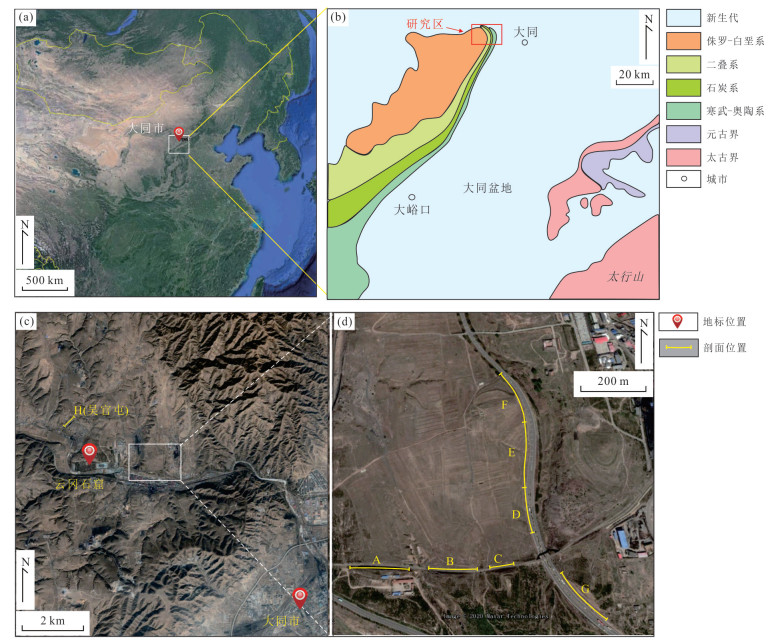
 下载:
下载:



